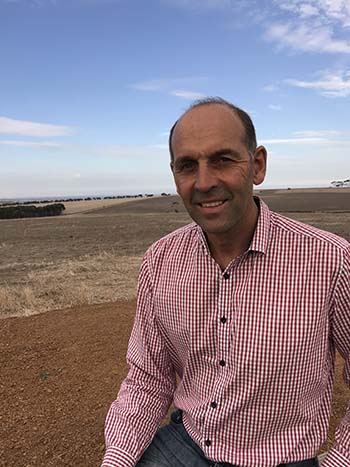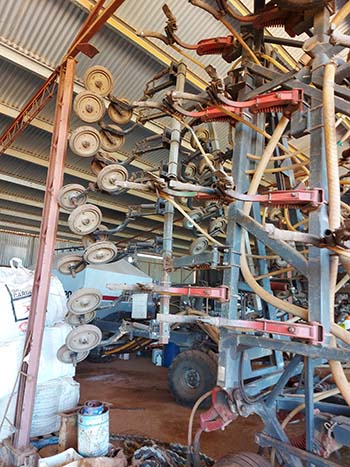Snapshot
Grower: Mark Modra
Location: Greenpatch, Edillilie, Yeelanna and Eyre Peninsula
Farm size: 2000 hectares over five small blocks
Enterprise: 25 per cent continuous cropping, 75 per cent mixed farming –one third Canola, one third Cereal, and one third legume, either grain or sometimes pasture, based on weed pressure and sheep demand
Annual rainfall: 400-600 millimetres
Growing season rainfall: 325-400mm
Soil types: Red Chromosol Loam (Yeelanna), with sands over deeper buckshot Ironstone gravels and sands over clay (Greenpatch, Edillilie and North Shields)
Cropping program: wheat, barley, canola, faba beans, lentil and lupins with sub-clover based pastures
Seeding equipment: 18 metre (60 foot) 820 Flexi-Coil air drill with press wheel and knife points (Greenpatch, North Shields and Edillilie); 9m Excel 38 centimetre (15 inch) double disc planter (Stubble Warrior) with Gyral 20-41SLR for his red-brown earth soils at Yeelanna – both are tow behind carts.
Mark Modra farms across a wide geographical area and operates two different sets of seeding equipment. On his more southern, gravelly and sandy land, Mark uses an 820 Flexi-Coil 18 metre bar, with a 2320 tow behind Flexi-Coil airseeder.

Mark Modra who farms across a wide geographical area on the Eyre Peninsula believes that while seeding equipment is important, weed control and rotation have a more significant impact on production.
Mark had to modify the rollers of this airseeder because the seed distribution wasn’t even enough. Once this was done, it allowed for sufficient adjustment when sowing canola.
“It also allows the rollers to run faster which evens out the distribution, particularly of the canola seed,” Mark says.
He made the modification ten years ago and is generally very happy with the result.
“I also custom made a heavy-duty primary sales type flexi-boot with a tungsten tile setup to sow both cereals and canola at the same depth, which makes determining the seeding depth ‘idiot proof’,” he says.
“This seems to work fine with sand/gravelly soils and when sowing with beans, I just put them down the fertiliser hose at the front.”
Mark’s more loamy soil around Yeelanna is sown with a 9m, Excel 38cm (15 inch) double disc planter (Stubble Warrior) with Gyral 20-41SLR air box tow behind with an air diffuser.
Mark is happy with the air cart, though he is concerned that the wider row spacings are too much of a compromise in regard to early vigour, weed control, and yield potential - particularly for cereals.
“It is well suited for canola and pulse production though,” Mark says.
“It sometimes struggles with penetration when sowing pulses dry. On the plus side, it allows me to use a glyphosate knock down later after sowing because it is true zero-till, and I do see benefit from that.”
Being a disc machine, as well as wide rows, Mark says the seeder set up also has good ability to handle high stubble loads, and to operate at high speeds, though the pre-emergent chemicals he can use are more limited.
To improve crop competition in more weed prevalent areas, Mark has been contemplating using zero-row spacing or broadcasting additional seed prior to sowing in these areas.
Fertiliser

Manutec press wheels of the Flexicoil bar which Mark questions the usefulness on his sand soil.
Mark’s sowing fertiliser program uses 60 kilograms per hectare MAP in canola to minimise toxicity.
He applies higher phosphorus in cereals to compensate for more product removal.
Mark says he doesn’t see much seed damage on either system but does make a point of checking for this with different batches of seed, particularly canola, as well as carefully checking legume germination before seeding.
Future
On the wetter and sandy type soils, Mark says he would like to be using variable rate seeding for enhanced crop competition.
Mark likes having his two systems which play to the strengths of both soil types in the two areas, but for sheer simplicity, he would like to move to one system in the future.
Mark says a narrower disc machine could be a future solution and he may try to buy more units for his Excel Disc or move to something like a John Deere type single: both for its larger size and narrower rows (even down to 6-7 inch).
Challenges
A challenge Mark sees in his area is “leaky” soils with poor ability to hold nutrients and water during cropping. He also sees the challenge of scale with broad acre farming and the community impact of less landholders working more land.
Pests
Mark deals with slugs, snails, earwigs, millipedes, bronze field beetles, false wireworm and crickets. He baits frequently for snails and slugs, with slugs being more of a challenge because it is harder to tell when and where they will be a problem.
Planting dry in late April and early May allows for crop development ahead of invertebrate pests, which has resulted in some decreased insecticide use recently.
Mark uses pre-emergent Sakura with triallate on his cereals across both tillage systems, having stopped using trifluralin a number of years ago.
Propyzamide is used on Mark’s canola with Simazine and Diuron doing a lot of the work with his pulse crops, and he broadly uses these combinations across all his farmland, and different tillage systems.
Top tips
Mark’s top plant establishment tips. While Mark does think that seeding equipment can be useful, in his mind, it is not as important as weed control and rotation in terms of impact on production. Mark’s plant establishment tips are to focus on:
- timing
- weed control
- rotation
- seeding machinery.
More information: Mark Modra, 0427 866 877, modsmc@gmail.com

























































